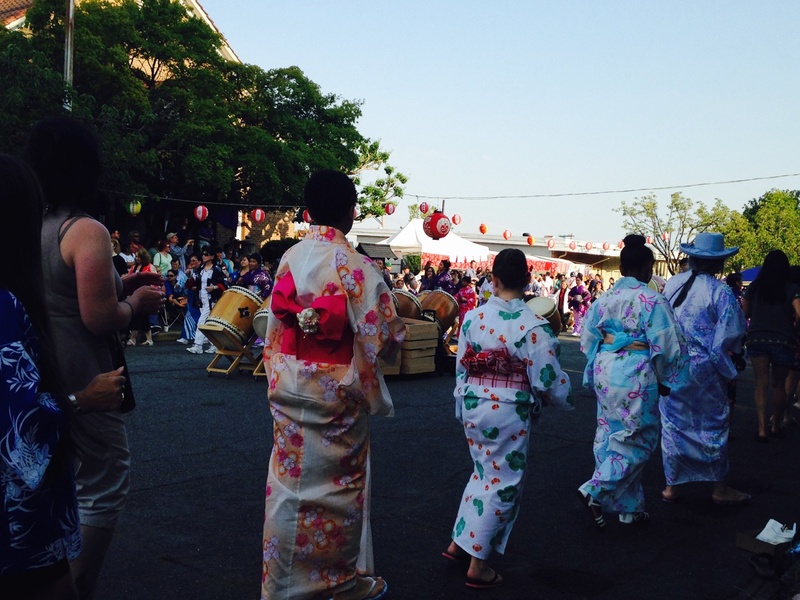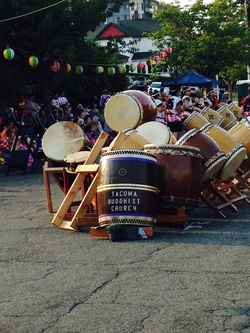Although I am not Buddhist, the circles of Bon Odori have always spoken to me. All the circles of dancers, all of their arms even raised in circles, mimicking the full moon. The round uchiwa fans, the strings of rounded lanterns bobbing slightly in the breeze, the circular heads of the taiko drums. Food, dancing, community, summer heat, celebration, reunion with the spirits of the ancestors—really, what more could you ask from a festival?
Obon is well-known in the Japanese American community as “a gathering of joy,” for good reasons. But it will always feel simultaneously painful, because my sister and I didn’t start going to Bon Odori until my father died.
I have to circle back first to my childhood Bon Odori celebrations. What I remember about those is the small gravelly parking lot at the Placer Buddhist Temple in Penryn, California. We danced in the Sacramento summer heat and the glowing cobalt blue sky just after sunset. We practiced in the gymnasium at the temple, with a stage at one end and a kitchen at the other, on speckled white linoleum floors.
Placer Bon Odori was very small. Sometimes, there were enough dancers for one stretched-out circle of dancers in the outer ring, marked by chalk lines. We did have a lot of props: kasa, sakura branches, enough uchiwa and sensu and kachi kachi for everybody to borrow. I don’t remember much focus on Obon food, other than shaved ice. (The temple saved much of that focus for its annual fall bazaar, with regionally renowned teriyaki chicken that you could smell for miles in the foothills.) And we had the strings of brightly colored lanterns, the ones from Kikkoman and Sho Chiku Bai sake.
Halfway through each practice, we drank cans of Sprite and Mountain Dew. During the breaks my sister and I liked to watch the koi swimming under the concrete bridge over the temple garden pond. We were usually the youngest dancers practicing. We danced from an early age all the way through high school, until I moved away to college, and I think I remember coming back for some of the college years. When we danced, the circles I inscribed with my arms felt solemn and respectful, like the stately Gasho Ondo.
I cherish this festival a great deal for its connections to my cultural heritage and community. However, I’ve come to realize that for me, Bon Odori will always feel bittersweet. It’s one thing to feel connected to the departed souls of your ancestors, those who may be from the distant past. It’s another thing to feel connected when one of those recently departed souls is your father. I was ten years old when he died, and my sister was six. Bon Odori is supposed to be about a happy reunion with the dead, but we were still reeling from the shock of death’s initial separation and its inexorable distance.
For many years, then, I did not think of Bon Odori as a gathering of joy. I liked going to the festivals, and I liked the dancing. Nevertheless, after my father died, anything that made us think about death—or made us think of him—was also knotted with pain.
I danced and danced, and then I didn’t dance for many years. The circles of my life shifted from California to graduate school and a career in Washington. I was excited to be at Bon Odori in Tacoma after so many years of missing it, but a little nervous too. I couldn’t find my happi coat. I wasn’t sure if I would know any of the dances.
I didn’t have to worry; once you’ve been to a few Bon celebrations, there are familiar elements that seem to cross over. Tacoma Bon Odori is a nice medium-sized festival, with the typical two circles of dancers, an inner circle of teachers and experienced dancers, and an outer circle of students. There is, of course, spam musubi and shaved ice. There are a few games for the kids to play. There are chicken teri and rice bowls. There were lanterns, and dances with the uchiwa and sensu, sakura branches, and taiko music. (Though I’ve lived in Washington for almost half of my life, I’m still a California girl, so I love that the Tacoma temple serves a Pacific Northwest treat for dessert: strawberry rhubarb pie, to be served in slices or purchased whole, to take home.)
But most of all I was worried about how I would feel loss again, and how it would feel to be at Bon Odori with my young daughters. We had talked about their grandfather before, but it took several years for me to be able to talk about him with them at all. I was still a little nervous.
Before I took my family, I had explained to my daughters what I knew about the significance of Bon Odori. We hadn’t been able to practice, but my oldest daughter wanted to dance anyway. We walked up the hill, towards the dancing, and she jumped right into the line. I followed her and looked into the inner circle for guidance. There was a “Tacoma Ondo” dance with live singers and taiko drums. After a few dances I relaxed enough to chant “a yoi yoi” along with the singers during the Tanko Bushi. I didn’t know that this is actually closer to the intent of Bon Odori than all my years of diligent practice: the willingness to surrender your self-conscious ego for the sake of learning, and for the sake of sheer joy in dancing.
There was so much joy there, dancing with my daughter. There was sadness too, but my daughter somehow understood that. As we were getting ready to leave, we passed a booth selling memorial candles in glass holders for people to light after sunset. “Can we buy one of those, Mama?” she asked. I didn’t think that she would be interested, but she was excited. We bought one of the candles and wrote the names of our family members on a label, then carefully placed the label around the glass holder.
We took the candle to the garden in back of the temple. We stood there for a few minutes, looking at the stone lantern, and the pond, and all the names of the beloved dead placed on glasses around the water. Later on into the evening, the glasses would be filled with light. Only then did I feel the circling that is Obon: the light of who was there and who wasn’t, the inexplicable meeting of both. There was my daughter dressed in my childhood yukata, my past wrapped brightly around my future. It was time to go home.
© 2014 Tamiko Nimura









